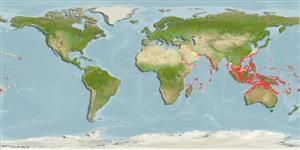Environment: milieu / climate zone / depth range / distribution range
Ecologia
marino associati a barriera corallina; non migratori; distribuzione batimetrica 0 - 80 m (Ref. 89707), usually 5 - 50 m (Ref. 37816). Tropical; 32°N - 24°S, 32°E - 153°W (Ref. 5222)
Indo-Pacific: Red Sea south to Mozambique and east to the Phoenix Islands, north to Japan, south to Australia. Probably including all the islands of the tropical Indian Ocean.
Length at first maturity / Size / Peso / Age
Maturity: Lm ?, range 30 - ? cm
Max length : 65.0 cm TL maschio/sesso non determinato; (Ref. 11441)
Spine dorsali (totale): 11; Raggi dorsali molli (totale): 14-16; Spine anali 3; Raggi anali molli: 8 - 9. This species is distinguished by the following characters: body and head elongate and markedly compressed, its depth distinctly less than head length, 3.1-3.7 times in standard length; body width 2.3-2.8 times in body depth; no palatine teeth; caudal fin rounded. Colour of adults greenish to brownish grey with numerous orange-red spots on head (becoming smaller anteriorly), body, dorsal fin, and basally on caudal fin;3-4 longitudinal whitish bands or series of streaks often visible on postorbital head and body; membranes of soft dorsal, anal, and caudal fins clear; juveniles with longitudinal pale bluish grey stripes on a gold or yellow background; a blue-edged black spot (or double spot) at base of caudal fin and another at base of soft dorsal fin (Ref. 5222, 39231, 90102).
Solitary adults inhabit coral rich areas and clear waters on lagoon and seaward reefs (Ref 90102). They feed mainly on fishes and probably on crustaceans. The distinctive blue and gold striped juveniles are mimics of the wrasse Halichoeres purpurescens (Ref. 39231) or dark damsels in surge zones (Ref. 48635). This allows the species to approach their preys. Often seen in markets but not plentiful enough to be of commercial importance. Caught with hook-and-line, spear, and probably in traps (Ref. 39231). Sold in Hong Kong live fish markets (Ref. 27253). Minimum depth reported taken from Ref. 128797.
Life cycle and mating behavior
Maturità | Riproduzione | Deposizione | Uova | Fecundity | Larve
Heemstra, P.C. and J.E. Randall, 1993. FAO Species Catalogue. Vol. 16. Groupers of the world (family Serranidae, subfamily Epinephelinae). An annotated and illustrated catalogue of the grouper, rockcod, hind, coral grouper and lyretail species known to date. Rome: FAO. FAO Fish. Synop. 125(16):382 p. (Ref. 5222)
IUCN Red List Status (Ref. 130435)
Threat to humans
Harmless
Human uses
Pesca: scarso interesse commerciale; Pesce da pesca sportiva: si
Informazioni ulteriori
BibliografiaAcquacolturaProfilo di acquacolturaVarietàGeneticaElectrophoresesEreditarietàMalattieElaborazioneNutrientsMass conversion
Strumenti
Special reports
Download XML
Fonti Internet
Estimates based on models
Preferred temperature (Ref.
123201): 24.9 - 29, mean 28 °C (based on 2014 cells).
Phylogenetic diversity index (Ref.
82804): PD
50 = 1.0000 [Uniqueness, from 0.5 = low to 2.0 = high].
Bayesian length-weight: a=0.01096 (0.00979 - 0.01228), b=3.04 (3.01 - 3.07), in cm total length, based on LWR estimates for this species (Ref.
93245).
Trophic level (Ref.
69278): 3.9 ±0.62 se; based on food items.
Resilienza (Ref.
120179): Medio, tempo minimo di raddoppiamento della popolazione 1.4 - 4.4 anni (Preliminary K or Fecundity.).
Fishing Vulnerability (Ref.
59153): Moderate to high vulnerability (46 of 100).
Nutrients (Ref.
124155): Calcium = 27.4 [17.4, 49.1] mg/100g; Iron = 0.454 [0.249, 0.752] mg/100g; Protein = 18.6 [16.8, 20.2] %; Omega3 = 0.142 [0.098, 0.213] g/100g; Selenium = 38.9 [24.4, 65.7] μg/100g; VitaminA = 81.6 [30.0, 247.1] μg/100g; Zinc = 0.963 [0.677, 1.322] mg/100g (wet weight);
